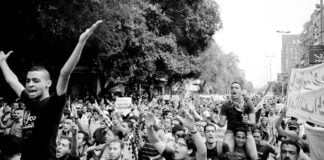The popular revolutions that brought down Stalinism were a rebellion against the ruling class in the East, not against socialism, argues Mark Gillespie
In the last months of 1989, a wave of revolutions swept across the so-called socialist countries of Eastern Europe.
By the end of the year the Berlin Wall—a symbol of oppression and the Cold War —had been brought down along with six hardline Stalinist regimes —Poland, Hungary, Czechoslovakia, East Germany, Bulgaria and Romania. Yugoslavia, Albania and the USSR collapsed in the years that followed in perhaps the most significant period of revolutionary upheaval since the Second World War.
Western politicians were quick to claim these revolutions as a victory for capitalism and the market. But the revolutions in 1989 were not rebellions against socialism. They were rebellions against a ruling bureaucracy, organised in the Communist parties, the nomenklatura, that ruled in the name of socialism. The nomenklatura exploited and oppressed the workers in the East, just as surely as their Western counterparts exploited workers under their control. The Stalinist regimes were brought down by a combination of economic crisis and class struggle.
Economically the Eastern Bloc had been pushed to breaking point by years of their smaller and less industrialised economies trying to militarily compete with the West. In the 1980s it was estimated the USSR was devoting over 20 per cent of its GDP to arms production, compared to 7 per cent for the US.
This spending had been sustained by starving the domestic economy of investment—resulting in crumbling infrastructure, housing shortages, crop failures, poor technological development, low wages and shortages of consumer goods.
As the crisis grew, so did the deep divisions between hardliners and reformers within the ruling elite. While reformers advocated deregulation and integration into the global economy, hardliners desperately fought to maintain the status quo. Increasingly the reformers looked to liberalising the political structures as a means of overcoming the entrenched hardliners.
The divisions at the top created opportunities for those at the bottom of society to push for real change.
Gorbachev
Mikhail Gorbachev came to power in Russia (which was the predominant power in the Soviet Union) in 1985 and began a reform program (glasnost and perestroika) that had a profound effect right across the Eastern bloc.
For years workers in Eastern Europe had lived with the threat of the Russian army. Russian troops had brutally smashed revolutions in Hungary in 1956 and Czechoslovakia in 1968. They had rumbled on the Polish border during the mass strikes and factory occupations in 1980 that created the free trade union movement, Solidarnosc (Solidarity).
Russian troops and the threat of invasion were the final sanction for the authoritarian Eastern European states. So, in 1988, when Gorbachev announced that Russia would not intervene in the internal affairs of the countries of Eastern Europe, those regimes were fundamentally weakened.
Eastern Europe
The Eastern European countries responded in two ways. East Germany’s Erich Honecker, committed to hardline Communist party control, organised a huge military parade to celebrate the construction of the Berlin Wall that separated East from West.
In Poland and Hungary, however, the reformers got the upper hand. A military coup in Poland had suppressed Solidarnosc in 1981. But a new wave of strikes developed in 1988, and the regime feared that if they didn’t give reform, they’d get revolution.
Changes in the USSR, Poland and Hungary encouraged East German workers to take to the streets. By October 1989, weekly demonstrations, initiated in churches, were growing rapidly and spreading across the country.
Honecker wanted to shoot the protesters off the streets. But a crucial turning point came on October 9. More than 60,000 protesters in Leipzig stared down massive intimidation by security forces. After a tense standoff, the security forces blinked, and shied away from large scale confrontation.
Honecker’s state was beginning to crumble. “We can’t beat up hundreds of thousands,” declared the head of East Germany’s secret police, the Stasi. On October 18 Honecker resigned, replaced by the slightly more liberal Egon Krenz.
Honecker’s resignation was a tremendous victory for the movement. The demonstrations grew even bigger. In Leipzig on October 23, more than 320,000 rallied out of a population of just over 500,000. On November 4, a million people gathered in Alexanderplatz in East Berlin.
Now the heat was on Krenz. In an attempt to keep some social control, he approved a limited opening of the Berlin Wall.
On November 9, however, days before the official opening, tens of thousands of East Berliners flooded the streets, overwhelmed the border guards, and forced the gates open. Paralysed by the mass demonstrations, Krenz was not willing to order the guards to open fire.
This was the beginning of the end for the regime. Every concession to the movement spurred it on. Krenz was forced to resign; the coalition of parties that had ruled East Germany for 40 years disintegrated; free elections were organised and parties advocating the unification of Germany won overwhelmingly.
The fall of the Wall sent shockwaves through Eastern Europe, encouraging others to revolt. In Czechoslovakia the regime collapsed after a student strike, occupations of theatres, a successful two-hour general strike, and demonstrations in the capital of up to 800,000 people.
Next was Bulgaria, where the regime tried limited reform. But a threatened general strike won more sweeping democratisation.
In Romania, the brutal Stalinist leader Nicolae Ceausescu attempted to deflect the anger onto the minority Hungarian community. But before long there was an uprising in Timisoara, Romania’s second city. Ceausescu tried to get control of the situation by calling a pro-government rally in the capital, Bucharest.
But rather than cheer the great leader, the people booed, then rioted. The next day a mass demonstration stormed his palace, forcing him to flee. Middle level party leaders and army generals organised a hasty coup. After a quick trial, Ceausescu was executed on Christmas Day, 1989.
Revolution
But what sort of revolutions were they?
The view pushed in the West is that the revolutions represented the triumph of capitalism over socialism. A closer look however reveals just how little had changed. Most of the repressive state institutions, the army, police and courts, remained untouched.
The elite of the nomenklatura either maintained their positions, transformed themselves into private capitalist owners (handing themselves ownership of former state property) or became politicians in the new parliamentary structures.
Nor was there any fundamental change for workers. In places more political rights were gained, but economically people often went backwards. Instead of “Western” living standards they got free market “shock therapy”. Privatisation and deregulation brought mass unemployment and a sharp rise in inequality.
In Poland, the rate of poverty increased from 15 per cent in 1989 to 59 per cent in 2003. The fact that there was little change to the elite or to the state institutions supports the theory argued by Solidarity, that the East was not socialist but state capitalist. The collapse of “party rule” did not mean the collapse of class rule. Rather than social revolutions, the 1989 revolutions were political revolutions that transformed bureaucratic state capitalism into market capitalism.
Round table discussions
Liberalising political structures—especially after long periods of authoritarian rule—always carries the potential for revolt from below to push well beyond the limited reforming agenda of those at the top of society.
In East Germany, for example, slogans such as “No more bureaucratic impositions” and “Abolish all privileges” began to appear at rallies. The Stasi reported that opposition groups were “active in a series of workplaces.” The revolutionary upheaval, however, was contained.
As the movements exploded in size and scope the reforming bureaucrats moved quickly to incorporate the once hounded dissidents into discussions about parliamentary reform and into the state apparatus itself.
In East Germany, the dissident group New Forum opposed a popular call for a general strike in exchange for “round table” discussions that ultimately led to parliamentary reforms. In Czechoslovakia the Communist Party appointed the leading dissident, Vaclav Havel, as President and established a “government of national unity”—including many previous dissidents—to oversee the smooth transition to parliamentary democracy.
But the opposition groups were ideologically confused. Increasingly, they took responsibility for implementing the neoliberal economic medicine. In Poland, the former Solidarnosc trade union leaders who once led strikes against cuts to food subsidies, turned into politicians introducing the “shock therapy”.
Workers accepted this neoliberal agenda because they were led to believe that after a “momentary dislocation” they would soon enjoy living standards similar to northern Europe.
The political confusion was compounded by the fact that much of the Western Left believed that the authoritarian regimes of the Soviet Union were forms of socialism.
The ruling elites boasted of the triumph of capitalism. The apologist for free market capitalism, Francis Fukuyama, declared it was the “end of history”. But a quick glimpse at Eastern Europe today shows how wrong he was.
The current global economic meltdown has caused havoc right across Eastern Europe. Fascist parties are on the rise in Hungary. In Russia, there are strikes and protests as workers resist the impact of the crisis. In Pikalevo unemployed workers blocked the main highway demanding back pay they are owed, and that factories in their town be reopened. Workers at the giant AvtoVAZ car plant have been staging protests against the threat of mass layoffs.
Military tensions have re-emerged between the US and Russia—most recently over Georgia and plans for a US missile defence shield in Nato countries.
The class struggle is far from over and the need to build a genuine socialist alternative to capitalism remains as necessary as ever.




